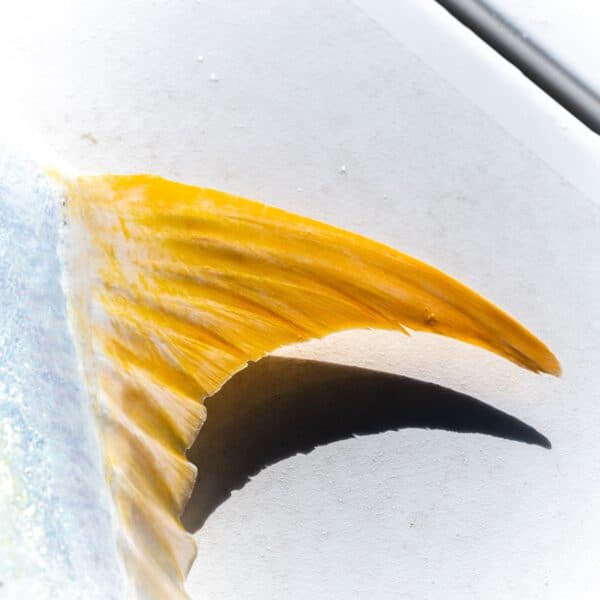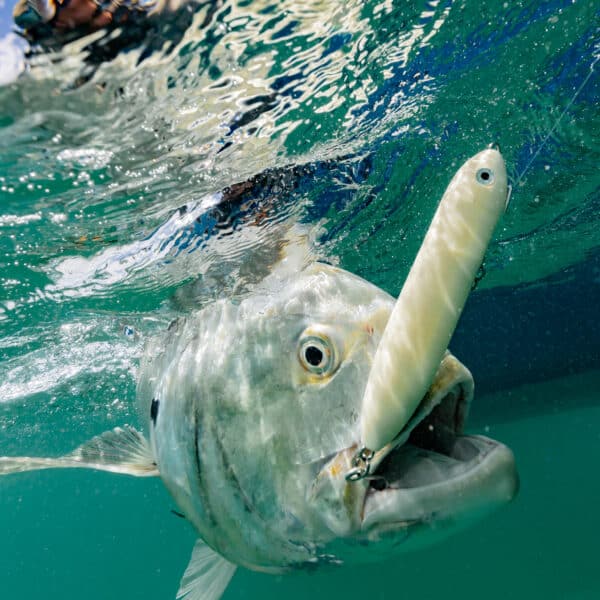Jack Crevalle
JACK CREVALLE
THE PROTOTYPICAL GAMEFISH
PUT RESPECT ON THE MIGHTY JACK
Understanding & Conserving Jack Crevalle
Inhabiting tropical and subtropical waters of the southeast Atlantic and Gulf of Mexico, jack crevalle have a significant cultural and economic impact in their sweepingly wide distribution. Despite their distribution and ideal angling attributes, jacks have received little of the respect they deserve. However, that respect is rapidly growing as Jacks receive more attention from anglers, scientists, and fisheries managers.
Hundreds of southeast guides rely on jacks to provide a quality experience for their anglers. Some use jacks to develop new anglers’ skills, while others build entire seasons of targeting the largest version of these ferocious predators. A growing community recognizes the groundswell of Jack popularity, leaning into this momentum while other inshore fisheries falter. Reliable species that book days are invaluable for our guides, and those same characteristics translate to opportunities for recreational anglers of all backgrounds.
ASGA stands to use science and education to advocate for sustainable fisheries management. We believe in Better Business Through Conservation and understand that a healthy resource benefits everyone. ASGA is wholeheartedly committed to working directly with local guide communities, recreational anglers, industry brands and retailers to ensure this remarkable fishery is better understood and protected for future.


The Jack project
A 5-Year Collaborative Research Project
The Jack Project is a first-of-its-kind comprehensive study on Jack Crevalle that employs each of the core tenets of our S.E.A. model. This process starts with Science. In conjunction with Florida International University, Mississippi State University, the Lower Keys Guides Association and our advocate community, The Jack Project will deploy 100 acoustic tags from South Carolina to Texas. These tags will ping off acoustic receiver arrays already in place along the breadth of the Atlantic Coast and the Gulf. Every time a tagged fish passes by a receiver, the data is recorded and compiled throughout the year. This movement data is crucial in helping understand their migratory patterns and potential sub-population distribution. The tagging areas are centric to key angling hot spots for jacks: South Carolina, the Treasure Coast of Florida, the Florida Keys, Louisiana and the Gulf Coast of Texas. These tags will provide over 5 years of core data on this crucial species. In addition to deploying the acoustic tags, fin clips will be taken so that stable isotope analysis can be completed.
Understanding the lifecycle and movements of this species is crucial to advocating for its protection. In the coming months and years, we will initiate the second stage in our model: Education. As Jack Crevalle are currently a data-poor species, furthering our understanding and communicating with the masses is crucial. With this new-found understanding and an army of empowered jack advocates, we hope to achieve sensible, precautionary management to conserve this incredible species.
Unmanaged and under appreciated
FLORIDA KEYS GUIDES SOUND THE ALARM
The plight of the jack crevalle has echoed around the iconic islands of the Florida Keys for years. While well known for trophy fisheries like tarpon, bonefish and permit, the Keys fishing guides are relentless stewards of the resources that support their tourism-driven economy. They recognize the value of reliable fisheries for their businesses and have noticed a declining jack population. In partnership with FIU and MSU, the Lower Keys Guides Association worked to deploy the first sets of acoustic tags on jacks in the Keys. Now, they are fighting to unify the voice for Jacks in their community and at the management level with FWC. In an interview with Fly Fisherman Magazine, Dr. Jennifer Rehage of FIU acknowledged that, “We know so little about Jacks. We tagged jacks near Key West that were barely 5 pounds, mostly because big jacks are so rare on the flats there these days. Our research showed that these little guys made it all the way to Louisiana and Texas. We were just astonished.”
There is still much to learn about the mighty Jack. Why are these fish disappearing from historically abundant Florida Keys hot spots? Why are some areas seeing less adult jack presence while anglers on the East Coast document impressive adult congregations during the spring? Are there separate sub-populations between the Gulf and Atlantic? What is the current state of the fishery in key Jack communities? We are excited to unify and amplify the fight to conserve an incredibly underrated resource. Stay tuned for more information and ways to get involved.
